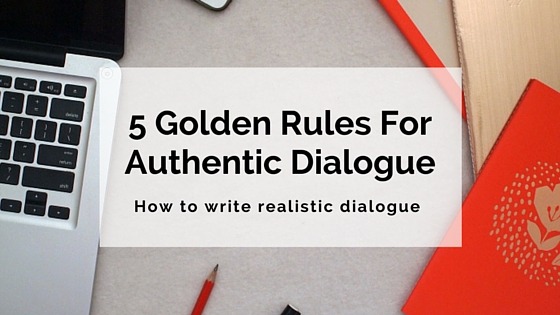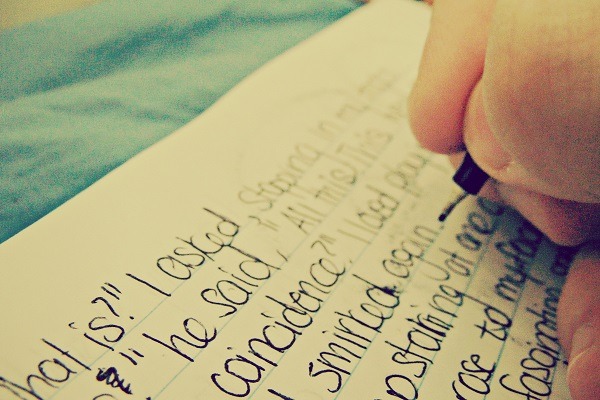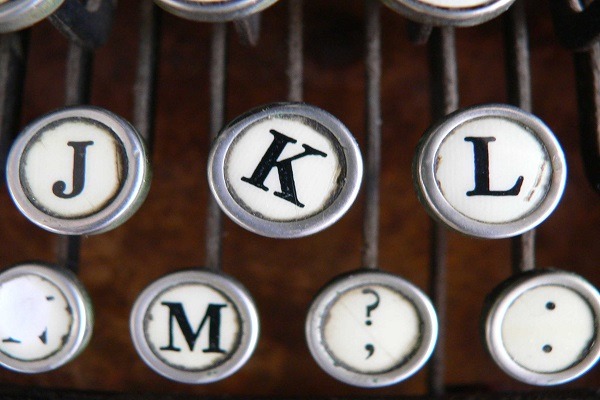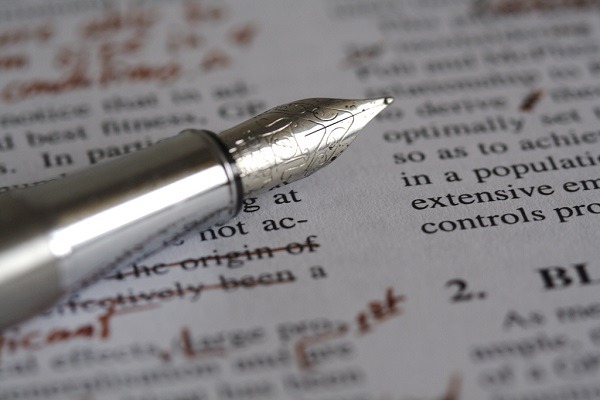Dialogue in fiction is almost a concrete requirement. We’re primarily referring to longform fiction here; short stories may exist without dialogue, but a novel sans speaking is a rare thing to find.
As Alice once said before her journey down the rabbit-hole, ‘What is the use of a book without pictures or conversation?’
Before we get into how to write dialogue, let’s talk about its primary function in fiction. Here’s what one of the greats has to say about dialogue as an essential story element:
In my view, stories and novels consist of three parts: narration, which moves the story from point A to point B and finally point Z; description, which creates a sensory reality for the reader; and dialogue, which brings characters to life through their speech.‘ – Stephen King
Without dialogue, we would have a very limited insight into a story’s characters. We wouldn’t know what they’re thinking, feeling, wanting; how they interact with each other; what their relationships are to one another and how this affects the story.
If we don’t know all this, we can’t really understand, relate to, or sympathise with these characters – which makes for a pretty dull story.

While dialogue does help with all this, it’s more than just character development. It’s also a way to create conflict, which is often the key to a great story; conversations between characters can also set the mood of the scene, whether it’s tense and dangerous or hopeful and full of promise.
Finally, dialogue can also be used to keep a story moving forwards. Important information is often delivered through characters’ dialogue, and advances in the plot are often centred around discussions, arguments, or revelations.
So, to summarise, dialogue should do one or more of the following things:
- Develop and provide insight into characters and their relationships with each other.
- Create mood, conflict, and tension.
- Propel the story/plot.
Now, we’re not going to pretend it’s easy to write dialogue that achieves all this effectively and engagingly. In fact, a lot of writers find dialogue to be one of the hardest elements of writing, and it seems to be universally agreed that it’s a difficult thing to do well.
But don’t worry! We’ve put together a set of golden rules for writing great dialogue, and if you learn how to follow them, you’ll be well on your way to making this a stand-out element in your fiction.

RULE #1: Aim for speech that’s realistic – but not too realistic
No matter what sort of fiction you write – whether it’s anchored concretely in reality, or set within a completely imaginary world – your dialogue is never going to be 100% realistic.
In fact, if you strive to make it so, your story will quickly become boring and even incomprehensible to readers.
The reason for this is that real human speech is messy. It’s not exactly like its written counterpart. Human conversations are full of stops and starts, ‘umm’s and ‘ahh’s, fragmented sentences and changes of topic. As screenwriter Christopher Guest points out:
In real life, people fumble their words. They repeat themselves and stare blankly off into space and don’t listen properly to what other people are saying. I find that kind of speech fascinating but screenwriters never write dialogue like that because it doesn’t look good on the page.’ – Christopher Guest
Guest is absolutely right, and not just about screenwriting. No piece of fictional writing will reproduce speech exactly as it occurs in real life. It’s just not feasible, and it certainly won’t enhance the story or win over any readers.
However…
There is a flip side. If you lean too far in the opposite direction and produce dialogue without paying any attention to real human speech, it will end up feeling stilted and contrived, jarring your readers right out of the story.
This jeopardises their sense of engagement with the plot and the characters, making them aware that it’s ‘just fiction’ they’re reading, when in fact you’re striving for the opposite effect.
So, considering both sides of the coin, here’s what you must do: write dialogue that is natural enough to be believable, but polished enough to be readable.

To learn how to do this, start using your powers of observation. Listen to real-world dialogue whenever you can. Eavesdrop on other people’s conversations. Pay attention to your own exchanges with people.
Observe how words bounce back and forth, how the conversation ebbs and flows, and how people communicate their thoughts, feelings, and intentions.
Nothing teaches you as much about writing dialogue as listening to it.’ – Judy Blume
In listening and making these observations, you will slowly learn how to capture the natural rhythm and flow of speech. This will infuse a sense of realism into your written dialogue, without it reading like an exact transcription.
A final tip for ensuring your dialogue is as realistic as it should be:
If you are using dialogue – say it aloud as you write it. Only then will it have the sound of speech.’ – John Steinbeck
Reading your work aloud has great benefits for regular narrative as well, but it’s especially effective for dialogue development.
If you speak a character’s line and stumble all over it, or if it comes out sounding completely alien, it’s a good indication that you need to refine it further.

RULE #2: Use dialogue tags and actions effectively
Attributing dialogue
First things first. Dialogue loses all sense and purpose if readers can’t follow who’s saying what, so you’ll need to make sure you effectively attribute (or ‘tag’) lines of dialogue to their speakers.
There are a number of ways to do this. The simplest and most common method, and the one generally championed by most literary types, is to use the word ‘said’. It’s clear, it’s unobtrusive, and it doesn’t feel forced or overly descriptive, as words such as ‘snarled’ or ‘gasped’ sometimes do.
This doesn’t mean you must use ‘said’ exclusively and shun all other verb tags. When it comes down to it, it’s a matter of personal preference, so if you prefer to mix things up a bit then feel free. But do keep in mind that, when in doubt, it’s best to keep things simple.
Truthfully, too, dialogue tags are somewhat akin to words like ‘and’ and ‘the’ in that readers’ eyes will often simply skip over them. Our brains acknowledge their presence in the context of the sentence, but we don’t really tend to pay them any further attention. So there’s no use spending all your time working on creative alternatives for dialogue tags!
Avoiding adverbs
In keeping your dialogue tags simple, it can be tempting to make up any perceived lack of description by introducing adverbs. This means decorating your ‘said’ tags with words such as ‘angrily’, ‘happily’, ‘shyly’ etc.
While this seems innocent enough at first glance, the truth is that the use of adverbs becomes more and more grating on the reader the more often they’re used!
Give your writing ability, and your readers, some credit – you wouldn’t spoon-feed readers an overwhelming amount of details in your narrative, so try not to do it in your dialogue either.
If you’ve really tapped into your characters and their personalities, it should be possible to portray the emotions, motivations, and thought processes behind their words without the use of adverbs. If you can do that, you’re already on the way to writing good dialogue.
It’s also better to show what the speaker is doing to suggest how they are speaking, so let’s take a look at one way to achieve this.

Including actions
Dialogue, both fictional and real, isn’t simply about who says what to whom and how they say it. We think this sums it up best:
Dialogue is not just quotation. It is grimaces, pauses, adjustments of blouse buttons, doodles on a napkin, and crossings of legs.’ – Jerome Stern
It’s very rare for people to sit down to an even, consistent, back-and-forth conversation, in which all participants’ attention is focussed solely on speaking or listening. And that’s actually lucky, because such an exchange would make for some pretty boring reading!
To capture the essence of true conversation and avoid the monotony of a long ‘he said/she said’ exchange, you can infuse your dialogue with snippets of small actions. Think: characters eating, brushing hair out of their eyes, or getting ready for work while simultaneously engaging in conversation.
These small actions, also known as beats, can serve a dual purpose. As well as breaking up dialogue, they also come in handy as occasional replacements for regular dialogue tags such as ‘said’.
Let’s look at an example. Consider the following exchange from Khaled Hossini’s The Kite Runner, noting how beats are used both to break up the use of dialogue tags and to demonstrate increasing tension.
‘Amir agha and I are friends,’ Hassan said. He looked flushed.
‘Friends?’ Assef said, laughing. ‘You pathetic fool! Someday you’ll wake up from your little fantasy and learn just how good of a friend he is. Now, bas! Enough of this. Give us that kite.’
Hassan stooped and picked up a rock.
Assef flinched. He began to take a step back, stopped. ‘Last chance, Hazara.’
Hassan’s answer was to cock the arm that held the rock.
‘Whatever you wish.’ Assef unbuttoned his winter coat, took it off, folded it slowly and deliberately. He placed it against the wall.
As you can see here, beats can be used to indicate who’s speaking in much the same way as the normal speech attribution tags we discussed above. They can also keep the scene moving along and building to its climax.
All good things in moderation, though: don’t overdo your use of beats. Using too many can overwhelm the point of the dialogue itself, and can be repetitious and distracting to the reader.
RULE #3: Use different dialogue styles to distinguish characters
Let’s come back to the notion of dialogue as an important tool for character development.
After you’ve mastered (or at least begun to practise) the art of natural-sounding dialogue, and after you’ve learned how to attribute it effectively, you’ll need to refine your style again.
This time, you’ll be making sure you haven’t written dialogue that sounds exactly the same from every character.
It’s an easy mistake to make: you get so caught up in trying to write good dialogue that you forget to make each character’s way of speaking unique enough to distinguish one from another.
This is all part of the characterisation process, though, and once you give a character a strong voice, you’ll find a lot of other things fall into place as well.
If you were to hypothetically look at a bunch of lines from books I’ve written, just out of context, hopefully you would be able to determine who said what… I try to strongly differentiate through dialogue.’ – Charles Soule
Start by picturing a particular character in your mind’s eye. You’ve no doubt thought about them a lot already: their history, where they’re from, the way they look, the way they behave. They’re almost like a real person to you, and you know everything there is to know about them.
Now sit down and engage them in a conversation. (We recommend doing this in your head rather than out loud, unless you’re in a room by yourself.) Use the mind’s ear, if you will, to allow this character to come to life in audible detail.
The way they speak should follow on naturally from the personality you’ve developed for them, and it’s your job to capture this effectively in their dialogue.

It’s up to you how you do this. One method you can try is phonetically reproduced dialogue – that is, the precise representation of pronunciation through spelling and punctuation. An example explains it better than anything, so let’s take a look at a piece of dialogue from a character hailing from America’s deep south:
Me and Cecil Edwards was the ones cut him down. He come in the store and told it like you’d tell it was rainin out. We went up there and walked in the barn and I seen his feet hangin. We just cut him down, let him fall in the floor. Just like cuttin down meat… The old man’s eyes was run out on stems like a crawfish and his tongue blacker’n a chow dog’s.’
– Child of God, Cormac McCarthy
McCarthy is a master of phonetic reproduction, especially with characters speaking in Southern dialects. He encapsulates the nuances of this manner of speech so clearly that, as a reader, you feel you can actually hear the character’s voice in your mind. Their particular accents and inflections become as clear as if they were playing on a recording.
Do exercise caution if you choose to try this method, though, as it can become a little difficult to read. Don’t overdo it; you don’t want to distract from what a character is saying by focusing overly hard on the way they’re saying it.
Characters and their speech habits can be differentiated in a number of other different ways as well, many of which are not so intense or complicated as phonetic representation.
Think about the people you know in real life, and how they speak. Some might only use short, clipped sentences; some might rant and ramble, barely pausing for breath. Allow these different speaking styles to inspire you, and read on to learn how to delineate them effectively.

RULE #4: Pay attention to punctuation
Similarly to the phonetic reproduction we discussed above, punctuation has a big effect on how people ‘hear’ a sentence in their head – something that’s particularly important when reading dialogue.
When you write straight narrative, you’re probably (and wisely) accustomed to sticking with basic punctuation, such as commas and the occasional semicolon. However, when writing dialogue, you shouldn’t be afraid to try out some punctuation you wouldn’t normally use in regular prose.
Well-considered punctuation can add a layer of realism to characters’ dialogue, representing the natural pauses and emphasis found in real-life speech.

Dashes are one example of punctuation that you may not use much in narrative, but that you might want to use more throughout dialogue. People are always interrupting each other (and themselves) when they’re speaking, especially in quick back-and-forth conversations, and a dash is perfect for indicating this.
Similarly, ellipses are rarely used throughout narrative, but can be helpful when a character’s train of thought trails off, or when there’s a long pause from the speaker.
As well as punctuation, formatting in general is an important feature of well-written dialogue. Always follow universal rules, such as taking a new line for each speaker and placing punctuation inside quotation marks. Make sure it’s always clear who is saying what (see the section on attribution tags and actions above).
You may find it helpful to write out a dialogue exchange roughly and freely at first, letting the words flow and not worrying about the technical details. Then you can go back to punctuate and format properly. Say the lines out loud how you imagine your characters saying them, and add punctuation accordingly.
There is an underlying rhythm to all text. Sentences crashing fall like the waves of the sea, and work unconsciously on the reader. Punctuation is the music of language.’ –Noah Lukeman
RULE #5: Create a balance between dialogue and narration
Looking back at our golden rules so far, many of them have revolved around balance. The delicate line between realism and style in written speech; the interplay between attribution tags and actions; the need for harmony between what is said and how it’s spoken – there’s a definite theme emerging here.
So perhaps balance can be considered the key to developing good dialogue. In that case, our final guideline is fitting: it deals with the balance between your characters’ dialogue and the rest of your story.
Dialogue in fiction should be reserved for the culminating moments and regarded as the spray into which the great wave of narrative breaks in curving toward the watcher on the shore.’ –Edith Wharton
As Ms Wharton so poetically puts it, longform fiction should never be too dialogue-heavy. You don’t want to overwhelm your readers with constant conversation after conversation; rather, you want to pepper your carefully crafted narrative passages with dialogue that relieves, informs, delights, and develops.
Don’t be overly frugal with your dialogue, though – novels do need a good amount to keep the story moving, to break up the narration and description, and to ensure readers stay engaged. It’s all a matter of equilibrium and perspective.
Read back through your work – or, better yet, get someone else to read it for you – and see if there are any extra-long stretches of narrative, unbroken by character interaction through dialogue.
Also check for the opposite: passages of dialogue that become tedious and repetitious, or are unnecessary for character or plot development.

RESEARCH TIP: Read authors renowned for dialogue
Here’s a bonus tip for those wishing to research the art of dialogue further. The following authors have been lauded widely for their aptitude in writing dialogue, so you may wish to study some of their works:
- Elmore Leonard
- John Steinbeck
- Ernest Hemingway
- Raymond Carver
- J. D. Salinger
- Oscar Wilde
- Jane Austen
- Cormac McCarthy
- Zadie Smith
Remember not to attempt to imitate these writers’ styles, but to allow their well-crafted dialogue to influence, guide, and inspire you when you write your own.
All writing is in fact cut-ups. A collage of words read heard overheard. What else?’ – William S. Burroughs

RESEARCH TIP: Study plays and film scripts
Play scripts and screenplays are made up almost entirely of dialogue. As such, they must drive much of the story through speech alone, so they’re a great source of inspiration and education for those writing dialogue in novels.
There are far more bookworms than play or film buffs here at Writer’s Edit, so rather than coming up with a set of recommendations here, we encourage you to get started by consulting a resource such as a list of major modern playwrights or top 10 best dialogue movies.
Whether you choose to read scripts or to watch the productions themselves, there are plenty of valuable dialogue writing tips to be picked up from plays and movies.

We’ll leave you with some fine words from playwright Tom Stoppard, who succinctly sums up the process (and the enjoyment) of writing dialogue:
Writing dialogue is the only respectable way of contradicting yourself. I put a position, rebut it, refute the rebuttal, and rebut the refutation.’ – Tom Stoppard
Sounds like fun, doesn’t it?
4 responses to “5 Golden Rules for Writing Authentic Dialogue”
I found this very informative. I love writing and just beginning. I live in Hopetoun WA and belong to a writer’s group named Scribes. I am always nagged about using too many adjectives.
Glad you found it useful, Elizabeth!
Thanks! This was really helpful. I’ve been avoiding writing a chapter in my novel for a few days because I was just stuck on dialogue, since the chapter includes a lot of dialogue and the purpose of this chapter was to create a sense of normalcy before the “rug is pulled from beneath the reader’s feet” and i was finding it exceedingly difficult to write dialogues naturally.
Hi Aalia,
Totally understand your difficulty with dialogue, especially during a tricky chapter! Happens to the best of us. So glad to hear this post helped out 🙂
All the best with your novel!